Deadlifting 101: Everything You Need to Know
Dec 4, 2024 mindpumpThe deadlift is one of the most powerful and fundamental exercises you can do in the gym, but it’s also one of the most misunderstood. If you’re new to deadlifting or looking to improve your form, you’re in the right place. Deadlifting can feel intimidating at first, but once you get the basics down, it’ll become one of your go-to lifts for building strength, power, and muscle.
What is the Deadlift?
The deadlift is one of the most powerful movements you can do. It works the entire posterior chain of your body (glutes, hamstrings, and lower back). This is often the weakest part of most peoples’ physique as we spend most of our day sitting, and hunched over. This causes atrophy and loss of activation of our back muscles and how to properly move our hips. In addition, it will target the core, traps, and forearms. No other exercise stimulates as many muscles at once as the deadlift. I personally consider it the king of all exercises, even above the squat.
How to Deadlift
We want to always prioritize form over intensity. It’s not just about getting stronger. We want to prevent injury. Letting our ego get in the way can cause you to get injured, resulting in less time spent in the gym doing the exercises you love or hitting your goals. Here are some key points to keep in mind:
-
Set Your Feet: Set your feet hip-width apart with the barbell over the middle of your feet. Toes can have a slight tilt outwards. Go with what you feel is most comfortable. Get your shins just shy of grinding against the bar.
-
Grip the Bar: Bend at the hips and reach for the bar with hands just outside the knees. You can use a double overhand grip or an alternating grip. Alternating will most likely become the preferred way as you get stronger, as it allows you to move more weight.
-
Set Your Back: Before lifting the bar, we want to remove the rounding of the back. Flatten your back. A good cue for this is to pretend like you’re about to break the bar in half over your shins. Create that tension that forces a flat back. Chest is up and shoulder blades down and back. Your lats will engage as you “break” the bar over your shins.
-
Drive Through the Heels: We want to focus on pushing through the heels, not our toes. Instead of trying to stand up, think of it as pushing the ground away from you. This will fire the glutes properly, as well as the hamstrings.
-
Finish Strong: As you get to the standing position, keep that chest up (think Superman position) and the shoulders staying down and back. You don’t need to over-extend or lean back, but drive the hips through the bar.
-
Lower the Bar Carefully: To lower the bar, you reverse the motion. Push your hips back first, not your knees, and guide the bar down with control. Don’t just drop it—lower it slowly until it reaches the ground, keeping your back neutral the whole time.
What to Avoid
Here is what we want to avoid:
-
Rounding the Lower Back: One of the most dangerous mistakes you can make is rounding your lower back during the deadlift. This puts excessive strain on the spine and can lead to injury. Always keep your back neutral or slightly arched.
-
Lifting with the Arms: Your arms should stay straight; you aren’t curling the bar. The hips and legs are doing all the work along with the back isometrically flexing. Keep the bar as close to your body as possible. Most people get injured when that bar starts traveling farther away from the midline adding excessive strain on the lower back.
-
Starting with the Hips Too Low: The hips should be higher than the knees, with the torso leaning slightly forward. Again, think about breaking the bar over your shins.
Deadlift Variations
-
Romanian Deadlift: A straighter leg version with not much break at the knees other than a slight bend. This will target more hamstrings.
-
Sumo Deadlift: If you want to engage more glute activation, this wider stance allows for that. It’s also a friendlier version for those who can’t quite get the full range of a traditional deadlift.
-
Trap Bar Deadlift: Using a hexagonal bar, the trap bar deadlift can be easier on the lower back and more accessible for beginners.
Why You Should Deadlift
Deadlifts are a staple exercise that should be a part of everyone’s routine. It activates the most muscles at once making it efficient and effective. It’ll improve your overall strength which is crucial for building size. Most importantly, it’ll improve your posture, strengthen the core, and help overall functionality. It allows you to move better throughout your day. You may find moving furniture and carrying groceries become effortless.
Deadlifting also has a unique carryover to other lifts, particularly the squat and the bench press. The stronger you get at deadlifting, the stronger you’ll become overall, which is why it’s such a valuable movement in any fitness routine.







